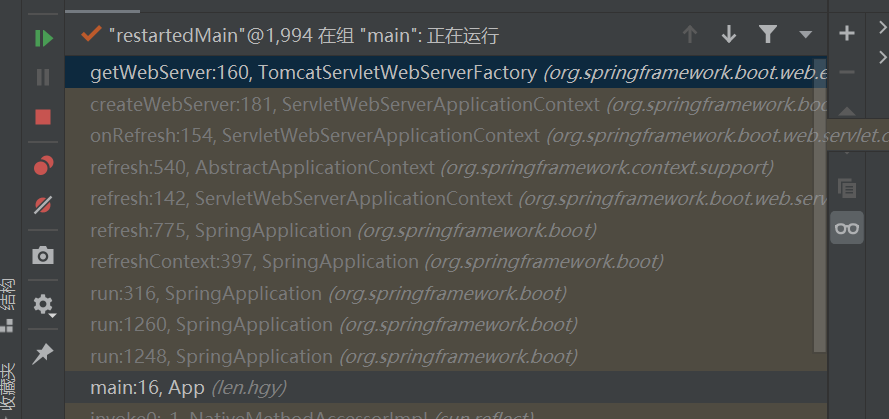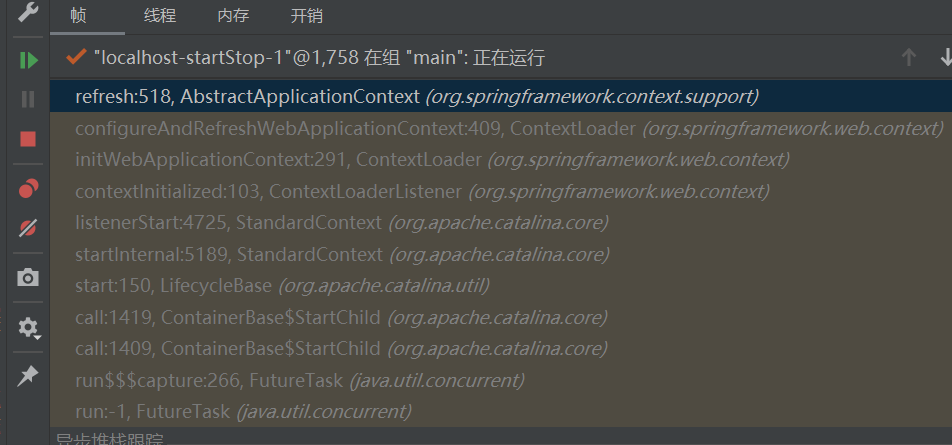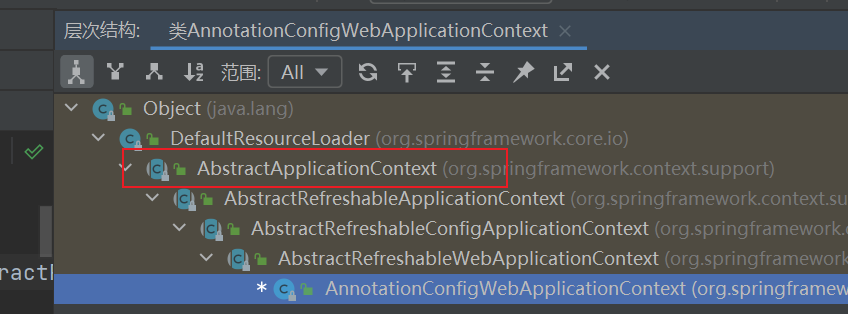三. SpringBoot原理
对于springboot来说,还有两块是比较有意思的,第一就是发现他内置了tomcat,接下来一快就是他对springmvc进行了无缝整合
1. 内嵌tomcat
首先来看下最简单的tomcat集成。
pom
<?xml version="1.0" encoding="UTF-8"?>
<project xmlns="http://maven.apache.org/POM/4.0.0"
xmlns:xsi="http://www.w3.org/2001/XMLSchema-instance"
xsi:schemaLocation="http://maven.apache.org/POM/4.0.0 http://maven.apache.org/xsd/maven-4.0.0.xsd">
<modelVersion>4.0.0</modelVersion>
<groupId>hgy</groupId>
<artifactId>embed-tomcat</artifactId>
<version>1.0-SNAPSHOT</version>
<dependencies>
<!--Java语言操作tomcat -->
<dependency>
<groupId>org.apache.tomcat.embed</groupId>
<artifactId>tomcat-embed-core</artifactId>
<version>8.5.11</version>
</dependency>
<!-- tomcat对jsp支持 -->
<dependency>
<groupId>org.apache.tomcat</groupId>
<artifactId>tomcat-jasper</artifactId>
<version>8.5.11</version>
</dependency>
</dependencies>
</project>
新建立一个servlet
package len.hgy.servlet;
import java.io.IOException;
import javax.servlet.ServletException;
import javax.servlet.http.HttpServlet;
import javax.servlet.http.HttpServletRequest;
import javax.servlet.http.HttpServletResponse;
public class IndexServlet extends HttpServlet {
@Override
protected void doGet(HttpServletRequest req, HttpServletResponse resp) throws ServletException, IOException {
doPost(req, resp);
}
@Override
protected void doPost(HttpServletRequest req, HttpServletResponse resp) throws ServletException, IOException {
resp.getWriter().print("this is index... tomcat");
}
}
tomcat 整合
package len.hgy;
import len.hgy.servlet.IndexServlet;
import org.apache.catalina.LifecycleException;
import org.apache.catalina.core.StandardContext;
import org.apache.catalina.startup.Tomcat;
public class MyTomcat {
private static final int PORT = 8080;
private static final String CONTEX_PATH = "/hgy";
private static final String SERVLET_NAME = "indexServlet";
public static void main(String[] args) throws LifecycleException, InterruptedException {
// 创建tomcat服务器
Tomcat tomcatServer = new Tomcat();
// 指定端口号
tomcatServer.setPort(PORT);
// 是否设置自动部署
tomcatServer.getHost().setAutoDeploy(false);
// 创建上下文
StandardContext standardContext = new StandardContext();
standardContext.setPath(CONTEX_PATH);
// 监听上下文
standardContext.addLifecycleListener(new Tomcat.FixContextListener());
// tomcat容器添加standardContext
tomcatServer.getHost().addChild(standardContext);
// 创建Servlet
tomcatServer.addServlet(CONTEX_PATH, SERVLET_NAME, new IndexServlet());
// servleturl映射
standardContext.addServletMappingDecoded("/index", SERVLET_NAME);
tomcatServer.start();
System.out.println("tomcat服务器启动成功..");
// 异步进行接收请求
tomcatServer.getServer().await();
}
}
运行main方法,在浏览器输入:
http://localhost:8080/hgy/index
注意: 9.xx版本的并不能直接访问
2. SpringMVC 整合
新增spring依赖
<dependency>
<groupId>org.springframework</groupId>
<artifactId>spring-web</artifactId>
<version>5.0.4.RELEASE</version>
<scope>compile</scope>
</dependency>
<dependency>
<groupId>org.springframework</groupId>
<artifactId>spring-webmvc</artifactId>
<version>5.0.4.RELEASE</version>
<scope>compile</scope>
</dependency>
UserService
package len.hgy.service;
import org.springframework.stereotype.Service;
@Service
public class UserService {
public String index() {
return "springboot 2.0 我正在加载UserService";
}
}
RestController
package len.hgy.controller;
import len.hgy.service.UserService;
import org.springframework.beans.factory.annotation.Autowired;
import org.springframework.web.bind.annotation.RequestMapping;
import org.springframework.web.bind.annotation.RestController;
@RestController
public class IndexController {
@Autowired
private UserService userService;
@RequestMapping(value = "/index", produces = "text/html;charset=UTF-8")
public String index() {
return userService.index();
}
}
DispatcherServlet配置类
虽然前面有了service,有了controller,但依然没有把这些组建交给spring,对于springmvc来说,有个DispatcherServlet,这是springmvc的前端控制器,以前是配置在web.xml中。只是现在用的是注解。
package len.hgy.conf;
import org.springframework.context.annotation.ComponentScan;
import org.springframework.context.annotation.Configuration;
@Configuration
@ComponentScan("len.hgy")
public class RootConfig {
}
package len.hgy.conf;
import org.springframework.context.annotation.ComponentScan;
import org.springframework.context.annotation.Configuration;
import org.springframework.web.servlet.config.annotation.EnableWebMvc;
import org.springframework.web.servlet.config.annotation.WebMvcConfigurer;
@Configuration
@EnableWebMvc
@ComponentScan(basePackages = {"len.hgy.controller"})
//public class WebConfig extends WebMvcConfigurerAdapter {
public class WebConfig implements WebMvcConfigurer {
}
package len.hgy.conf;
import org.springframework.context.annotation.Configuration;
import org.springframework.web.servlet.support.AbstractAnnotationConfigDispatcherServletInitializer;
@Configuration
public class SpringWebAppInitializer extends AbstractAnnotationConfigDispatcherServletInitializer {
// 加载根配置信息 spring核心
protected Class<?>[] getRootConfigClasses() {
return new Class[]{RootConfig.class};
}
// springmvc 加载 配置信息
protected Class<?>[] getServletConfigClasses() {
return new Class[]{WebConfig.class};
}
// springmvc 拦截url映射 拦截所有请求
protected String[] getServletMappings() {
return new String[]{"/"};
}
}
Tomcat集成
TomcatApp
package len.hgy;
import java.io.File;
import javax.servlet.ServletException;
import org.apache.catalina.LifecycleException;
import org.apache.catalina.WebResourceRoot;
import org.apache.catalina.core.StandardContext;
import org.apache.catalina.startup.Tomcat;
import org.apache.catalina.webresources.DirResourceSet;
import org.apache.catalina.webresources.StandardRoot;
public class TomcatApp {
public static void main(String[] args) throws ServletException, LifecycleException {
start();
}
public static void start() throws ServletException, LifecycleException {
// 创建Tomcat容器
Tomcat tomcatServer = new Tomcat();
// 端口号设置
tomcatServer.setPort(9090);
// 读取项目路径 加载静态资源
StandardContext ctx = (StandardContext) tomcatServer.addWebapp("/", new File("src/main").getAbsolutePath());
// 禁止重新载入
ctx.setReloadable(false);
// class文件读取地址
File additionWebInfClasses = new File("target/classes");
// 创建WebRoot
WebResourceRoot resources = new StandardRoot(ctx);
// tomcat内部读取Class执行
resources.addPreResources(
new DirResourceSet(resources, "/WEB-INF/classes", additionWebInfClasses.getAbsolutePath(), "/"));
tomcatServer.start();
// 异步等待请求执行
tomcatServer.getServer().await();
}
}
启动,在地址栏输入:
http://localhost:9090/index
JSP支持
要支持JSP,回忆学习springmvc中的内容,需要用到一个试图解析器
修改WebConfig
@Configuration
@EnableWebMvc
@ComponentScan(basePackages = {"len.hgy.controller"})
//public class WebConfig extends WebMvcConfigurerAdapter {
public class WebConfig implements WebMvcConfigurer {
// 创建SpringMVC视图解析器
@Override
public void configureViewResolvers(ViewResolverRegistry registry) {
InternalResourceViewResolver viewResolver = new InternalResourceViewResolver();
viewResolver.setPrefix("/WEB-INF/views/");
viewResolver.setSuffix(".jsp");
// 可以在JSP页面中通过${}访问beans
viewResolver.setExposeContextBeansAsAttributes(true);
registry.viewResolver(viewResolver);
}
}
新增controller
@Controller
public class UserController {
@RequestMapping("/pageIndex")
public String pageIndex() {
return "pageIndex";
}
}
增加JSP
在resources里面新增WEB-INF\views\pageIndex.jsp
<%@ page language="java" contentType="text/html; charset=UTF-8" pageEncoding="UTF-8" %>
<!DOCTYPE html PUBLIC "-//W3C//DTD HTML 4.01 Transitional//EN" "http://www.w3.org/TR/html4/loose.dtd">
<html>
<head>
<meta http-equiv="Content-Type" content="text/html; charset=UTF-8">
<title>jsp page</title>
</head>
<body>
<h1>这是个jsp页面</h1>
</body>
</html>
重启tomcat ,访问 http://localhost:9090/pageIndex
3. SpringBootTomcat 加载流程
tomcat如何启动的?
org.springframework.boot.autoconfigure.EnableAutoConfiguration=\
...
org.springframework.boot.autoconfigure.web.servlet.ServletWebServerFactoryAutoConfiguration,\
...

ServletWebServerFactoryAutoConfiguration 这类里面有个TomcatServletWebServerFactoryCustomizer这个类实现了WebServerFactoryCustomizer
@Configuration
@AutoConfigureOrder(Ordered.HIGHEST_PRECEDENCE)
@ConditionalOnClass(ServletRequest.class)
@ConditionalOnWebApplication(type = Type.SERVLET)
@EnableConfigurationProperties(ServerProperties.class)
@Import({ ServletWebServerFactoryAutoConfiguration.BeanPostProcessorsRegistrar.class,
ServletWebServerFactoryConfiguration.EmbeddedTomcat.class,
ServletWebServerFactoryConfiguration.EmbeddedJetty.class,
ServletWebServerFactoryConfiguration.EmbeddedUndertow.class })
public class ServletWebServerFactoryAutoConfiguration {
EmbeddedTomcat->TomcatServletWebServerFactory->TomcatServletWebServerFactory.getWebServer()->getTomcatWebServer->TomcatWebServer->启动tomcat
// Start the server to trigger initialization listeners
this.tomcat.start();
在注入bean时候已经在构造器里面启动了tomcat
getWebServer谁调用的?

SpringApplication.run(App.class, args);
org.springframework.boot.SpringApplication#refreshContext
org.springframework.context.support.AbstractApplicationContext#refresh (Spring启动的核心方法)
org.springframework.boot.web.servlet.context.ServletWebServerApplicationContext#onRefresh
org.springframework.boot.web.servlet.context.ServletWebServerApplicationContext#createWebServer
org.springframework.boot.web.embedded.tomcat.TomcatServletWebServerFactory#getWebServer
大致分析:
? 更具classpath中的class分析出当前的项目类型是REACTIVE, SERVELET, NONE, 如果是SERVLET类型创建ServletWebServerApplicationContext的Context, 在AbstractApplicationContext的onRefresh()的钩子方法调用ServletWebServerApplicationContext的onRefresh()方法调用createWebServer(),最终调用如下代码和Tomcat挂钩
if (webServer == null && servletContext == null) {
ServletWebServerFactory factory = getWebServerFactory();
this.webServer = factory.getWebServer(getSelfInitializer());
}
以上是SpringBoot在OnRefresh()中启动Tomcat的逻辑, 其实还是在Spring的refresh()流程中
Tomcat如何初始化Spring呢?
只需要在refresh()方法打一个断点就知道了

其中有好几个异步追踪, 说明Tomcat初始化Spring使用的是异步线程方式
main线程
? tomcatServer.start();
? server.start();
? startInternal(); 提交异步任务
异步任务线程1
异步任务线程2
? listener.contextInitialized(tldEvent);
? public void contextInitialized(ServletContextEvent event) {
? this.initWebApplicationContext(event.getServletContext());
? }
? configureAndRefreshWebApplicationContext的实例是AnnotationConfigWebApplicationContext
而AnnotationConfigWebApplicationContext的继承结构是

所以在调用refresh()方法就会触发spring初始化的核心逻辑
而此时的onRefresh()钩子方法不会触发再次Tomcat启动, 所以不会出现Tomcat重复启动
@Override
protected void onRefresh() {
this.themeSource = UiApplicationContextUtils.initThemeSource(this);
}
4. SpringBoot 启动流程分析
准备工作
ApplicationContextInitializer Context初始化后调用的类
SpringApplicationRunListener SpringBoot运行监听的类
ApplicationRunner/CommandLineRunner 两个几乎可以等价,用于启动后做客户自定义的操作
MyApplicationRunner
@Component
public class MyApplicationRunner implements ApplicationRunner {
@Override
public void run(ApplicationArguments args) throws Exception {
System.out.println("MyApplicationRunner.run()执行了");
}
}
MyCommandLineRunner
@Component
public class MyCommandLineRunner implements CommandLineRunner {
@Override
public void run(String... args) throws Exception {
System.out.println("MyCommandLineRunner.run()执行了" + Arrays.asList(args));
}
}
MyApplicationContextInitializer
public class MyApplicationContextInitializer
implements ApplicationContextInitializer<ConfigurableApplicationContext> {
@Override
public void initialize(ConfigurableApplicationContext applicationContext) {
System.out.println("MyApplicationContextInitializer.initialize()执行了" + applicationContext);
}
}
MySpringApplicationRunListener
public class MySpringApplicationRunListener implements SpringApplicationRunListener {
//必须有的构造器
public MySpringApplicationRunListener(SpringApplication application, String[] args) {
}
@Override
public void starting() {
System.out.println("MySpringApplicationRunListener.starting()执行了");
}
@Override
public void environmentPrepared(ConfigurableEnvironment environment) {
System.out.println("MySpringApplicationRunListener.environmentPrepared()执行了");
}
@Override
public void contextPrepared(ConfigurableApplicationContext context) {
System.out.println("MySpringApplicationRunListener.contextPrepared()执行了");
}
@Override
public void contextLoaded(ConfigurableApplicationContext context) {
System.out.println("MySpringApplicationRunListener.contextLoaded()执行了");
}
@Override
public void started(ConfigurableApplicationContext context) {
System.out.println("MySpringApplicationRunListener.started()执行了");
}
@Override
public void running(ConfigurableApplicationContext context) {
System.out.println("MySpringApplicationRunListener.running()执行了");
}
@Override
public void failed(ConfigurableApplicationContext context, Throwable exception) {
System.out.println("MySpringApplicationRunListener.failed()执行了");
}
}
在resources/META-INF/spring.factories增加
org.springframework.context.ApplicationContextInitializer=len.hgy.listener.MyApplicationContextInitializer
org.springframework.boot.SpringApplicationRunListener=len.hgy.listener.MySpringApplicationRunListener
创建SpringApplication
SpringApplication源码
public static ConfigurableApplicationContext run(Class<?> primarySource,
String... args) {
return run(new Class<?>[] { primarySource }, args);
}
其实SpringBoot启动就着两个步骤,先创建ConfigurableApplicationContext ,然后再调用Run方法。
ConfigurableApplicationContext 是其他方式接入Spring的入口上下文
SpringApplication构造方法源码
public SpringApplication(ResourceLoader resourceLoader, Class<?>... primarySources) {
this.resourceLoader = resourceLoader;
Assert.notNull(primarySources, "PrimarySources must not be null");
//保存主类
this.primarySources = new LinkedHashSet<>(Arrays.asList(primarySources));
//判断当前是什么类型项目, Tomcat启动Spring不需要判断,因为使用Tomcat就说明是SERVLET类型
this.webApplicationType = WebApplicationType.deduceFromClasspath();
//从类路径下找到META-INF/spring.factories配置的所有 ApplicationContextInitializer
setInitializers((Collection) getSpringFactoriesInstances(
ApplicationContextInitializer.class));
//从类路径下找到META-INF/spring.factories配置的所有ApplicationListener
setListeners((Collection) getSpringFactoriesInstances(ApplicationListener.class));
this.mainApplicationClass = deduceMainApplicationClass();
}
Run方法
核心方法
public ConfigurableApplicationContext run(String... args) {
StopWatch stopWatch = new StopWatch();
stopWatch.start();
ConfigurableApplicationContext context = null;
Collection<SpringBootExceptionReporter> exceptionReporters = new ArrayList<>();
configureHeadlessProperty();
//从类路径下META‐INF/spring.factories,取得 SpringApplicationRunListeners;
SpringApplicationRunListeners listeners = getRunListeners(args);
//回调所有的获取SpringApplicationRunListener.starting()方法
listeners.starting();
try {
//封装命令行参数
ApplicationArguments applicationArguments = new DefaultApplicationArguments(
args);
//准备环境
ConfigurableEnvironment environment = prepareEnvironment(listeners,
applicationArguments);
configureIgnoreBeanInfo(environment);
//创回调SpringApplicationRunListener.environmentPrepared();
//表示环境准备完成
//打印 Banner
Banner printedBanner = printBanner(environment);
//根据环境创建context
context = createApplicationContext();
//错误的异常报表
exceptionReporters = getSpringFactoriesInstances(
SpringBootExceptionReporter.class,
new Class[] { ConfigurableApplicationContext.class }, context);
//准备上下文环境;
//将environment保存到ioc中;
//applyInitializers()调用所有的ApplicationContextInitializer的initialize方法
//调用所有的SpringApplicationRunListener的contextPrepared();
prepareContext(context, environment, listeners, applicationArguments,
printedBanner);
//SpringApplicationRunListener的contextLoaded
//刷新容器
//扫描,创建,加载所有组件;
refreshContext(context);
afterRefresh(context, applicationArguments);
stopWatch.stop();
if (this.logStartupInfo) {
new StartupInfoLogger(this.mainApplicationClass)
.logStarted(getApplicationLog(), stopWatch);
}
//所有的SpringApplicationRunListener回调started方法
listeners.started(context);
//获取所有的ApplicationRunner和CommandLineRunner进行调用
callRunners(context, applicationArguments);
}
catch (Throwable ex) {
handleRunFailure(context, ex, exceptionReporters, listeners);
throw new IllegalStateException(ex);
}
try {
//所有的SpringApplicationRunListener的running();
listeners.running(context);
}
catch (Throwable ex) {
handleRunFailure(context, ex, exceptionReporters, null);
throw new IllegalStateException(ex);
}
return context;
}
注意
ApplicationContextInitializer是在构造方法中从spring.factories中获取初始化的
SpringApplicationRunListener是在run中获取的
callRunners(context, applicationArguments); // 会调用所有的ApplicationRunner和CommandLineRunner
private void callRunners(ApplicationContext context, ApplicationArguments args) {
List<Object> runners = new ArrayList<>();
runners.addAll(context.getBeansOfType(ApplicationRunner.class).values());
runners.addAll(context.getBeansOfType(CommandLineRunner.class).values());
AnnotationAwareOrderComparator.sort(runners);
for (Object runner : new LinkedHashSet<>(runners)) {
if (runner instanceof ApplicationRunner) {
callRunner((ApplicationRunner) runner, args);
}
if (runner instanceof CommandLineRunner) {
callRunner((CommandLineRunner) runner, args);
}
}
}
spi的bean不需要加注解就可以导入到Spring中, Runner需要加注解才能导入